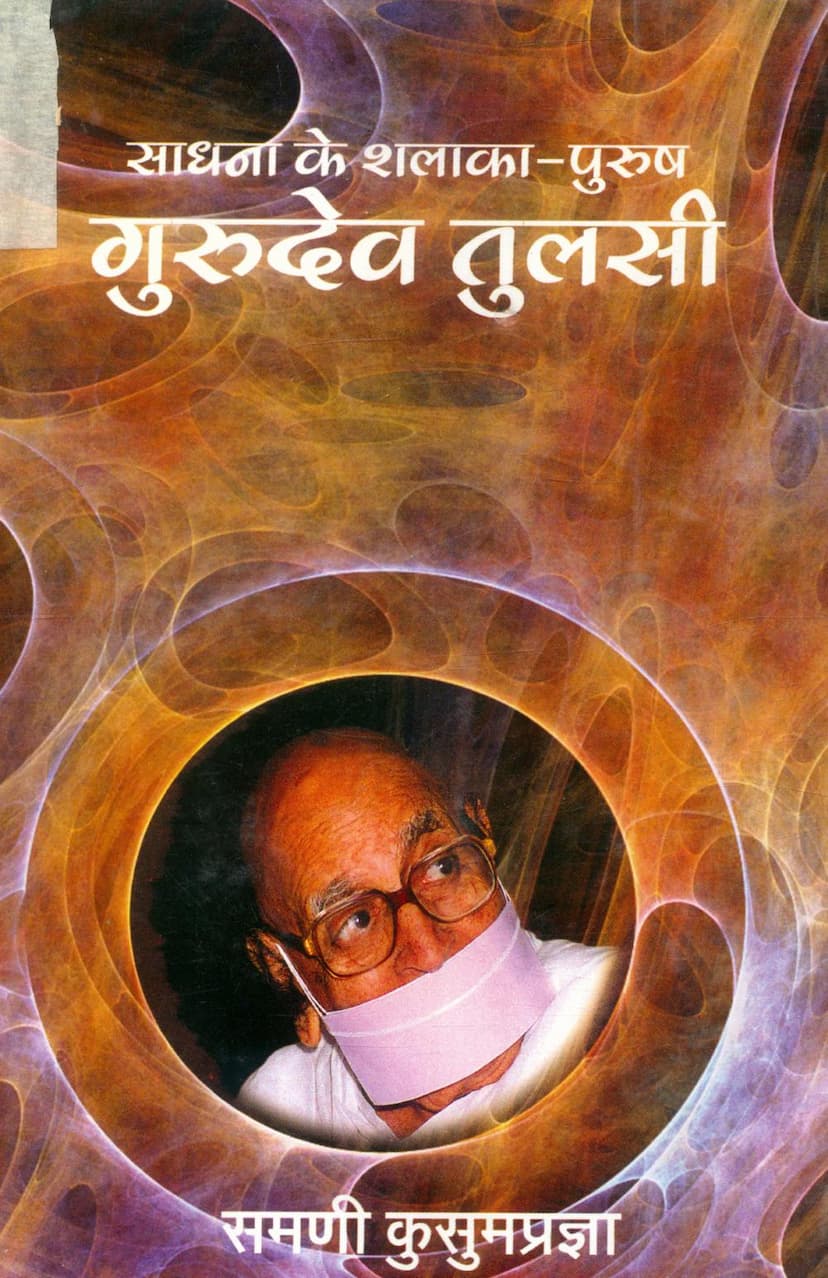Sadhna Ke Shalaka Purush Gurudev Tulsi
Added to library: September 2, 2025

Summary
Here's a comprehensive summary of the Jain text "Sadhna Ke Shalaka Purush Gurudev Tulsi" by Samani Kusumpragya:
This book, "Sadhna Ke Shalaka Purush: Gurudev Tulsi" (Pillars of Spiritual Practice: Gurudev Tulsi), authored by Samani Kusumpragya and published by Jain Vishva Bharati, is a detailed exploration of the spiritual journey and multifaceted personality of Acharya Tulsi, a revered spiritual leader and social reformer.
Core Theme:
The central theme of the book is the profound spiritual practice and multifaceted capabilities of Acharya Tulsi. It aims to present a living history of his spiritual discipline and immense potential, highlighting how he integrated spirituality and practice into public life.
Key Aspects of Acharya Tulsi's Life and Teachings as Presented:
-
A Dedicated Sadhu and Social Reformer: Acharya Tulsi himself often stated that while people might or might not call him a religious leader, he was primarily a "sadhak" (spiritual practitioner) and a "samaj-sudharak" (social reformer). His spirituality was not confined to personal practice but was actively extended to benefit society.
-
A Person of Profound Qualities: He is described as knowledgeable, a yogi, a shastra (teacher), a perfected soul, and someone who embodied tolerance, humility, and gratitude as innate qualities.
-
Sadhana and Experimentation: The book details his personal spiritual experiments and his inspiration to his disciples to undertake similar practices. Even in his later years, he consistently engaged in practices like asana, pranayama, meditation, kayotsarga, and preksha dhyana.
-
The "Shalaka Purush" (Pillar of Excellence): The title itself signifies him as a benchmark or guiding figure in spiritual practice. The book aims to illuminate various dimensions of his sadhana.
-
Holistic Personality: Acharya Tulsi possessed an attractive exterior and an equally pure interior. He was a capable administrator of a large spiritual community, radiating an extraordinary aura of self-discipline. He was imaginative, creative, a supporter of traditional practices, and deeply engaged in experimentation. His own life was his greatest laboratory, and he transformed his monastic order into a living one.
-
Discipline with Compassion and Firmness: His disciplinary style was marked by both immense affection and occasional strictness, balancing "vatsalya bhav" (loving affection) with "kathorta" (strictness). Despite his strictness, he maintained great purity and a sense of detachment from worldly matters.
-
Overcoming Adversity: His life was marked by significant opposition and obstacles, but his courage, valor, and wisdom allowed him to navigate through adverse circumstances.
-
Focus on Practical Spirituality: Acharya Tulsi believed that spirituality should be integrated into daily life, not confined to temples or specific rituals. He actively worked to make spirituality practical and accessible, believing that a religion without life-transforming power becomes mere ritual.
-
Pioneering Movements: He initiated significant movements and organizations, including the Anuvrat movement, Preksha Dhyana, and Jeevan Vigyan, and established institutions like Jain Vishva Bharati and Anuvrat Vishva Bharati. These initiatives aimed at societal upliftment and spiritual awakening.
-
Universality of Spirituality: He transcended sectarian boundaries, believing that spirituality was for all of humanity. He strived to make spirituality relevant and accessible, moving it from religious institutions into practical life. He often said he preferred to be called a "sadhanapurush" (man of spiritual practice) rather than a "dharmaguru" (religious leader).
-
The Book's Structure and Content: The book, comprising approximately 350 pages, is divided into four sections and includes about 68 articles. It delves into various aspects of Acharya Tulsi's sadhana, including:
- Objective of Sadhana: Dedication to the goal, struggle against negative influences, enthusiasm for returning to the source, training for an artistic life, development of mental purity, concentration, and fear of sin.
- Preceptor of Universal Spirituality: Establishing a universal spiritual outlook.
- Practitioner of Spirituality: Detailing personal sadhana practices like dietary discipline, asanas, pranayama, kayaotsarga, mantra repetition, silence, self-study, meditation, contemplation, concentration, generosity, detachment, freedom from passions, self-reflection, attitude management, alertness, monastic discipline, and the impact of these practices.
- Fruits of Sadhana: Achievements like integrity, self-awareness, right perception, selfless action, non-attachment, acceptance of weaknesses, fearlessness, balanced yoga, naturalness, tolerance, balance in action and inaction, experiencing innate bliss, simplicity, humility, harmony of conviction and practice, faith, observer-witness attitude, positive outlook, strong resolve, inner awakened potential, self-control, non-violent tendencies, lightness, and transcendental meditation.
-
The Author's Perspective: The author, Samani Kusumpragya, is praised for her dedicated research, analytical skills, and skillful presentation of this complex subject. Her writing is acknowledged as insightful and capable of making Acharya Tulsi's spiritual practices accessible to a wider audience. The book is seen as a fitting tribute to his memory.
In essence, "Sadhna Ke Shalaka Purush: Gurudev Tulsi" is a comprehensive biographical and spiritual work that illuminates the life, practices, and enduring legacy of Acharya Tulsi, presenting him as a true "Shalaka Purush" who demonstrated the power and relevance of spiritual discipline in transforming both individual lives and society as a whole.